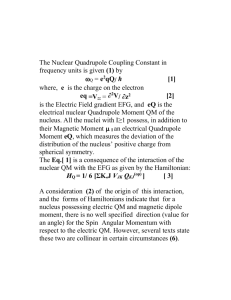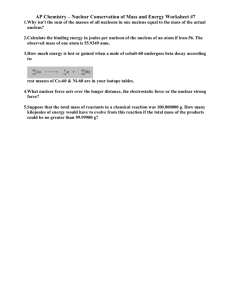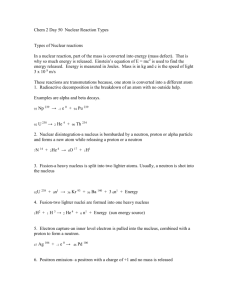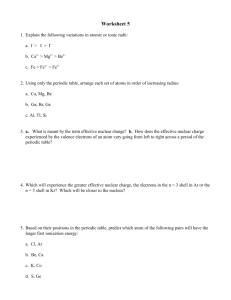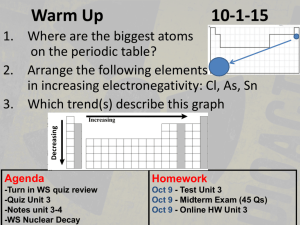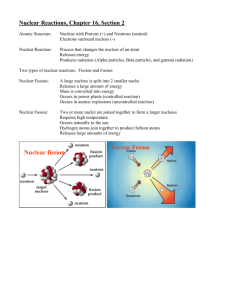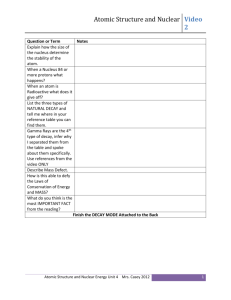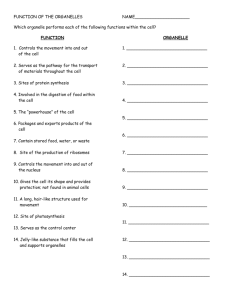Shell Model IV - collective model
advertisement
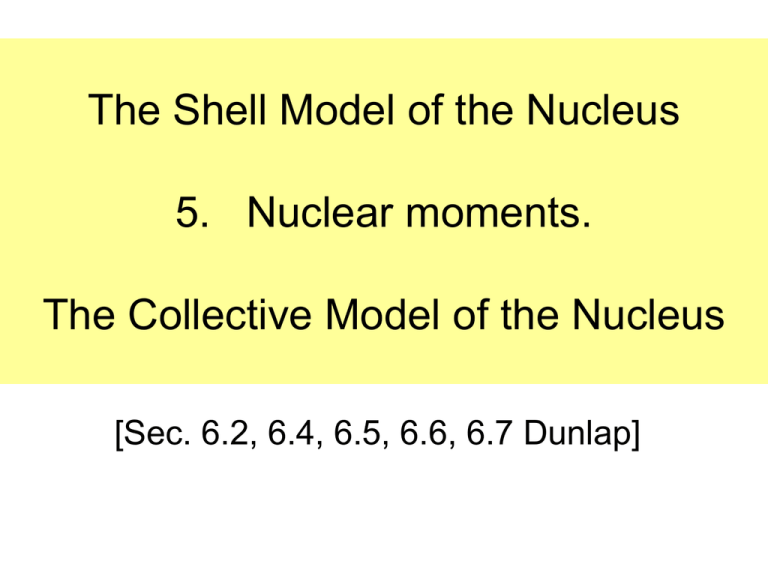
The Shell Model of the Nucleus 5. Nuclear moments. The Collective Model of the Nucleus [Sec. 6.2, 6.4, 6.5, 6.6, 6.7 Dunlap] The Bohr-Mottelson Collective Model of the Nucleus James Rainwater Aage Bohr Ben Mottelson (1917 – 1986) (1922 – (1926 – U.S.A Denmark USA / Denmark Between about 1950 – 1955, Bohr and Mottelson followed the idea on collective nuclear motion suggested by Rainwater. All three received the 1975 Nobel Prize – “For their work on the connection of collective nuclear motion with single particle motion” Electric nuclear moments The electrostatic energy associated with charge distribution (r) in electric potential (r) is: 3 eZ (r ).d r ELECTRIC CHARGE , d 3r 3 U (r ) (r )d r 3 P (r )r .d r ELECTRIC DIPOLE r + - 2 2 3 Q (r ) 3z r .d r ELECTRIC QUADRUPOLE + + + - Electric and Magnetic nuclear moments “For symmetry reasons the electric dipole moment of the nucleus (as well as all other static multipole moments with odd parity; for example – magnetic monopole, magnetic quadrupole or electric octupole) must VANISH. WHY? Because the both the strong and the electric forces are invarient under the parity operation – which means we should never get different nuclear properties under space inversion The nuclear Quadrupole moment Q PROLATE “Cigar” Q0 Q0 OBLATE “Dou-nut” Q0 Unlike atoms – nuclei can easily distort from spherical state. Unlike atoms the potential the nucleons move in is formed by the nucleons themselves. [In an atom it is the potential coming from the nucleus that dominates] The nuclear Quadrupole moment Q Quadrupole Moment (Barns) Q Magic Numbers The regions of sphericity Limits of manmade nuclides 56 28 16 8 Ni28 (5.6d ) QUESTION – will mankind ever make this double magic? O8 40 20 Ca 20 Quadrupole moment on the Shell model Q0 An extra proton or neutron added to a closed shell configuration makes an OBLATE ellipsoid Q0 A proton or neutron removed from a closed shell configuration make a PROLATE ellipsoid Quadrupole moment on the Shell model missing Odd proton extra Q (r )(3z 2 r 2 ).d 3r nlj * (r )(3z r ) nlj (r )d r 2 2 3 2 j 1 r2 1( j 1) QM expression missing Odd neutron extra Advanced treatment For a uniformly charged sphere: 3 2 3 2 2/3 r R Ro A 5 5 2 Deformation effects shell states Nilsson Model In a nonspherical nucleus a definite direction is defined – the direction 3 along the axis. The total angular momentum j is projected along the 3rd axis to give a new quantum no. K. = ± j, ±(j-1), ± (j-2) etc. This phenomenon also splits the degeneracy previously seen for spherical (closed shell) nuclei The Nilsson Shell Model Plot for Deformed Nuclei Nuclide 19 9 10 F Q 0.06b Shell Nilsson Expt 0.05 5 2 1 2 1 2 3 2 3 2 3 2 3 2 21 10 Ne11 0.09b 0.09 5 2 23 11 Na12 0.14b 0.11 5 2 Irrotational collective rotation of the nucleus Nuclear collective rotation occurs around an axis perpendicular to the symmetry axis “3” The rotation is called irrotational because the nucleus is not quite solid – It is largely the “skin” of “outer shape” of the nucles that is rotating Collective rotational motion J Consider energy of a rigid rotator with moment of inertia and J I 1 2 J2 E I 2 2I 1 ˆ2 Schroding Eqn : J E 2I 2 J ( J 1) EJ , J ,m YJ ,m ( , ) 2I The nucleus can also vibrate Breathing mode – Quadrupole Deformation First observed in 1977 – very high energy Rotating wave with Sherical Harmonic Wavefunction – circulates – or vibrates the nucleus. Requires nuclear fluid compressibility Spin = 2, Parity = + Nuclear vibrations are bosonic 106 46 Pd 60 The giant dipole resonance p n PHOTON CROSS SECTION (mb) High energy photon E E 14MeV .c .3x10 23 Fs 1 c 197 MeV .F 2 x10 22 s 1 PHOTON ENERGY (MeV) Nuclear magnetic moments z s The magnetic moment of the nucleus comes about because j l (1) We have charged particles – protons moving around the center of the nucleus (i.e. p, d, f, g etc states) (2) Both protons and neutrons have their own INTRINSIC magnetic moments. s p g sp N ( s / ) 5.586 N ( s / ) n g sn N ( s / ) 3.826 N ( s / ) proton For the PROTON we must add the mag mom due to ORBITAL motion to get the full mag. Mom. g lp N l g sp N s g lp 1 For the NEUTRON we can write down a similar equation but define that gln=0 After time averaging rapid motion about j then l (l 1) 34 1 i 2 N ( g li g si ) j ( g li g si ) j 1 gln 0 See SEC 6.6 MAGNETIC MOMENT (nuc magnetons) Magnetic dipole moments JACKNIFE ODD NEUTRON STRETCH NUCLEAR SPIN J Shown are the “Schmidt lines” Magnetic dipole moments MAGNETIC MOMENT (nuc magnetons) Shown are the “Schmidt Lines” named after German physicist T. Schmidt who discovered these lines empirically in 1937. ODD PROTON STRETCH ODD NEUTRON JACKNIFE NUCLEAR SPIN J
